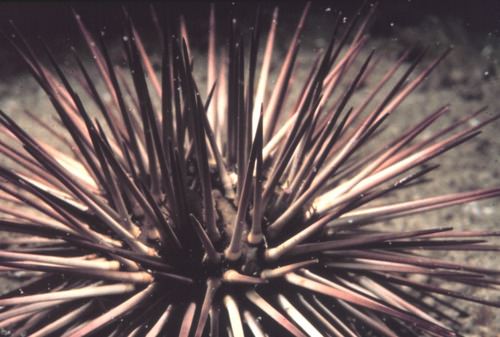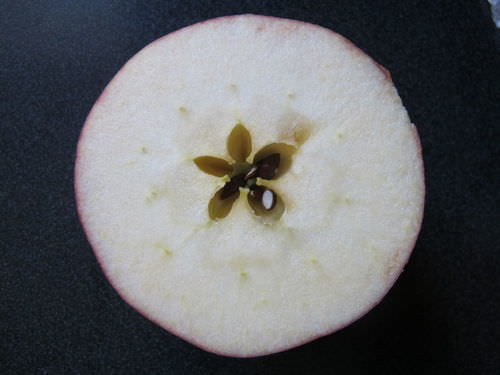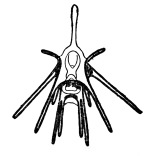15.42 精密神经药 -- -- 高级
Section outline
-
Believe it or not, this is an . See the mouth and arms?
::信不信由你,这是个笑话 看到嘴巴和手臂了吗?It is a sea lily, a crinoid echinoderm. Crinoids are essentially a mouth on the top surface that is surrounded by feeding arms. Although the basic echinoderm pattern of fivefold symmetry can be recognized, most crinoids have many more than five arms. Crinoids usually have a used to attach themselves to a surface, but many become free-swimming as adults.
::它是一种海,一种树脂,一种树脂,一种树脂。 树脂基本上是顶部表面的嘴,周围是用手喂养的。 虽然可以识别五倍对称的基本石脂模式,但大多数树脂的手臂超过五根。 树脂通常有固定在表面的习惯,但许多人成年后会自由游动。Characteristics of Echinoderms
::近效药的特征Echinoderms are organisms that make up the phylum Echinodermata . Members of the phylum include sea stars (starfish), sea urchins, sea cucumbers, sand dollars, brittle stars, and feather stars. There are 7000 different living of echinoderms and 13,000 identified species. Although the number of echinoderm species is very small compared to the number of species within the phylum, Echinodermata is the largest phylum to lack freshwater and species. Another distinction is that echinoderms are among the most distinct organisms within the animal . You learned in the Evolution concepts that evolution is not a linear series of steps and does not necessarily lead to increasing levels of complexity over time. It is based on the response of of species to the adaptive pressures of their environments and favors those that have the greatest reproductive success.
::植物杂草是构成植物类的有机体。植物类成员包括海星(海星)、海胆、海参、海参、沙元、小星星和羽星。有7000种不同的生态动物和13 000种经鉴定的物种。尽管与植物类中物种的数量相比,植物类物种的数量非常小,但植物类是淡水和物种中最缺乏的植物类。另一个区别是,动物类中最独特的生物类中,动物类中最独特的生物类。你从进化概念中了解到,进化不是一连串步骤,而且不一定随着时间的推移导致复杂性的上升。它基于物种对其环境适应性压力的反应,并且有利于那些具有最大生殖成功的物种。The phylum Echinodermata provides an excellent example of the non-linear, bush-like trajectory of evolutionary change. Echinoderms are the most closely related phylum to the phylum Chordata , which includes many complex organisms such as humans. Their shared common ancestor was likely a bilaterally symmetrical organism with a cephalized (centralized in a head region) . Yet, as you will learn in this lesson, many details of are simpler than those of this likely predecessor. The organisms within this phylum evolved these structures as adaptations to the pressures placed on them by their environments, just as the various groups within the phylum Chordata did. You will see in this chapter that the results of these two evolutionary paths are very different, despite having a fairly recent common origin. Let’s take a look at some of the distinguishing features of echinoderms, and then we will examine their structures and how they function in more detail.
::phylum Echinodermata 提供了非线性、像灌木一样的进化变化轨迹的极好例子。 精密植物是与phylum Chordata 最密切相关的植物, 包括许多复杂的生物, 如人类。 他们共同的共同祖先很可能是一个双边的对称生物, 并带有一种呼吸系统( 集中到一个领导地区 ) 。 然而, 正如你从这个教训中将会学到的, 许多细节比这个可能的前任更为简单。 这个植物中的有机体发展了这些结构, 以适应它们的环境给它们带来的压力, 正如 phylum Chordata 中的各个群体所做的一样。 您可以在本章中看到这两种进化路径的结果非常不同, 尽管它们有着相当新的共同起源。 让我们看看这些技术的显著特征, 然后我们再研究它们的结构及其如何更详细地运作。The word Echinodermata means “spiny skin.” If you have ever seen a sea urchin, like the one shown in Figure , then this name will certainly seem fitting. Although these spines may look like components of an exoskeleton at first glance, echinoderms do not have an exoskeleton. Instead, the spines are extensions of an internal endoskeleton . The endoskeleton is composed of calcium carbonate plates and spines that are actually covered by a thin layer of epidermis (skin). These plates and spines are held together by mesodermal tissue .
::Echinodermata 这个词的意思是“皮质皮肤 ” 。 如果你曾经见过海胆,如图中所示,那么这个名字当然会看起来很合适。尽管这些脊椎乍一看可能看起来像外骨骼的成分,但脑脊椎没有外骨骼。相反,脊椎是内骨骨骼的延伸。内骨骨骼是由碳酸钙板和脊柱组成的,实际上由一层薄薄的皮层(皮肤)覆盖。这些板块和脊椎由线骨组织连接在一起。A spiny sea urchin species. Notice the many long spines that look like exoskeletal projections. These spines are actually part of the echinoderm's endoskeleton; a layer of epidermal tissue covers each spine. As mentioned earlier, echinoderm species, such as those shown in Figure , look very different from most other invertebrates . This is partly due to their symmetry and their spiny endoskeleton.
::如前所述,如图所示的脑电离层物种与大多数其他无脊椎动物大不相同,部分原因是它们的对称性和脊椎内骨骼。Various types of echinoderms. (a) Feather star. (b) Sea star (starfish). (c) Brittle star. (d) Sea urchin. (e) Sand dollars. (f) Sea cucumber. Most of the phyla we have discussed so far (except and cnidarians) exhibit bilateral symmetry , meaning that they can only be divided into two equal halves by a single cut along the middle of the anterior-posterior (front-back) axis. Although echinoderms evolved from a bilateral ancestor, adult echinoderms exhibit five-fold radial symmetry called pentameral radial symmetry, which is depicted in Figure . This means that their bodies have five similar regions positioned around a central axis.
::迄今我们讨论的大多数植物(除了和尼达里人之外)表现出双边对称性,这意味着它们只能通过沿前置(前置)轴轴的中间一切一切而分为两等分之二。 虽然脑电离子从双边祖先演变而来,但成年脑电离子表现出五倍的半射线对称性,如图所示。这意味着它们的身体在中央轴周围有五个相似的区域。A cross section of an apple, illustrating pentameral symmetry. Pentameral symmetry in echinoderms refers to the arrangement of the body parts into five equal sectors around the mouth or central region, just like the seeds are arranged around the core of this apple. Unlike the adults, echinoderm larvae , such as the one shown in Figure , are always bilaterally symmetrical, reflecting the fact that radial symmetry evolved secondarily from a bilaterally symmetrical ancestor.
::与成年人不同的是,幼虫(如图中所示的幼虫)在双边之间总是对称的,这反映出辐射对称从双边对称祖先的第二位演变而来。An echinoderm larva. The larval stages of echinoderms are always bilaterally symmetrical, like the one shown here, even though adults are radially symmetrical. This reflects the fact that radial symmetry evolved secondarily in echinoderms from a bilaterally symmetrical ancestor. One highly unique feature of echinoderms is an organized network of canals throughout the body called the water vascular system that functions in , feeding, excretion , and respiration . The water vascular system uses water pressure generated through muscle contractions to move the organism. We will look at this hydraulic system in more detail in the next section.
::水血管系统利用肌肉收缩产生的水压来移动有机体。我们将在下一节更详细地研究这一液压系统。Unlike , , and arthropods, echinoderms are not protostomes . The species of the phylum Echinodermata and the phylum Chordata are all deuterostomes . In the Introduction to Animals and Invertebrates chapter you learned that there are a number of differences between protostomes and deuterostomes, all having to do with their patterns of embryonic . These are where differences between the two lie:
::与节肢动物和节肢动物不同,脑电介质并非原生体。植物的物种和植物的Chordata都是脱子体。在动物和无脊椎动物的引言中,你了解到原生体和脱子体之间有一些差异,这些差异都与它们的胚胎模式有关。-
Pattern of the first several
divisions.
::最初几个司的模式。 -
When the fate of embryonic cells becomes fixed.
::当胚胎细胞的命运 被固定。 -
Formation of the
coelom
.
::骨架的形成 -
Formation of the mouth and anus.
::嘴和肛门形成
In deuterostomes, the first several cell divisions are described as radial cleavage because they take place in parallel to or perpendicular to the axis of the embryo . Another feature of these early cells is that they do not have a set fate. For example, if one cell is removed from the embryo at this stage (8-cell stage), it is still capable of dividing to form all of the cells of an entirely new organism. This contrasts the early cell divisions in protostomes that produce cells with a fixed cell fate. If they are removed from the embryo, they will only be able to divide and differentiate into a few different cell types, so they are not capable of producing a new organism. Another difference between protostomes and deuterostomes is the origin of the mouth. In protostomes, the blastopore becomes the mouth. In deuterostomes, the blastopore becomes the anus, and another opening generated later in development produces the mouth. The blastopore is the first opening of the digestive cavity that is formed during the gastrulation stage of embryonic development, as shown in Figure .
::在离子体中,前几个细胞分解被描述为半径裂,因为它们与胚胎轴平行或垂直发生。这些早期细胞的另一个特征是它们没有固定的命运。例如,如果在这一阶段将一个细胞从胚胎中移除(8细胞阶段),它仍然能够分裂成一个全新的生物体的所有细胞。这比对了产生细胞和固定细胞命运的细胞的原细胞的早期细胞分解。如果从胚胎中取出,它们只能分裂和区分成几种不同的细胞类型,因此它们无法产生新的生物。原细胞和离子体之间的另一个差异是胚胎的起源。在原细胞阶段,爆破将变成嘴部。在离子体细胞中,破布变成肛门,而在发育后产生的另一个开口将产生口。Bombopore是胚胎发育阶段形成的消化腔的第一个开口,如图所示。Blastopore and coelom formation during gastrulation. In deuterostomes, the coelom begins to form as mesodermal pouches that fold in from the endoderm, and the blastopore eventually develops into the anus. In protostomes, the blastopore develops into the mouth. The deuterostome mouth originates as a second opening that forms later in development. Orange = ectoderm, red = endoderm, and blue = mesoderm. Finally, protostomes and deuterostomes each have different ways of forming a coelom, or body cavity. In protostomes, the mesoderm (middle tissue layer) splits into two sheets of tissue, and the space between these sheets becomes the fluid-filled body cavity. Deuterostomes form a coelom by invaginating pockets of endodermal (internal tissue layer) tissue from the developing gut cavity formed during gastrulation ( Figure ). The tissue surrounding the pockets differentiates into mesodermal tissue, and the pockets become the coelom.
::最后,蛋白质和离子体各有不同的方式来形成骨骼或体腔。在原体细胞中,中间组织层(中层组织层)分裂成两张组织板,而两张床之间的空间变成液体填充体腔。从在凝固过程中形成的正在发育的肠道腔(内部组织层)中插入内部(内部组织层)组织口袋,从而形成骨骼。口袋周围的组织会区分成分子组织,口袋会变成阴道。The echinoderm coelom is well-developed, and it forms two major cavities during development. One cavity becomes the actual coelom that houses internal organs , while the other develops into the water vascular system. In the next section we will take a closer look at the water vascular system, the endoskeleton, and other structural features of echinoderms.
::脑电流是发达的,在开发过程中形成两大洞。 一个洞变成了内脏内脏的实际洞穴,而另一个洞则进入了水血管系统。 在下一节,我们将更仔细地研究水血管系统、内骨骼以及脑电流的其他结构特征。Summary
::摘要-
Members of the phylum Echinodermata include sea stars (starfish), sea urchins, sea cucumbers, sand dollars, brittle stars, and feather stars.
::植物类Echinodermata的成员包括海星(海星)、海胆、海参、海参、沙元、小星星和羽毛星。 -
Echinoderms are the most closely related phylum to the phylum Chordata, which includes many complex organisms such as humans.
::Echinodom是与Hylum Chordata最密切相关的植物,后者包括许多复杂的生物,如人类。 -
Echinoderms are deuterostomes that exhibit pentameral radial symmetry.
::蛋白质是离子体, 表现出五元半径对称。 -
The water vascular system, used for locomotion, is unique to echinoderms.
::用于移动的水血管系统是脑电图所独有的。
Review
::回顾-
Although there are not as many echinoderm species as there are arthropods, the echinoderms are still the largest phylum in which environment?
::虽然没有象节肢动物那样多的精密动物物种,但精密动物仍然是其中最大的植物群? -
Echinoderms are closely related to the phylum Chordata, which includes humans, even though they look more closely related to cnidarians. What is one clue that support the theory that echinoderms are related to chordates?
::神经缺氧与包括人类在内的植物乔尔塔密切相关,尽管它们看起来与辛达里亚人的关系更为密切。 支持关于神经缺氧与染色体相关理论的线索是什么? -
How does early cell development differ between protostomes and deuterostomes?
::早期细胞发育在原生体和离子体之间有何区别? -
How does the coelom develop in deuterostomes?
::肠结叶是如何在子宫外发育的? -
Unlike other animals, the coelom of echinoderms forms two cavities. What are these two cavities for?
::与其他动物不同,脑电球形成两个空洞。这两个空洞是为了什么?
-
Pattern of the first several
divisions.





